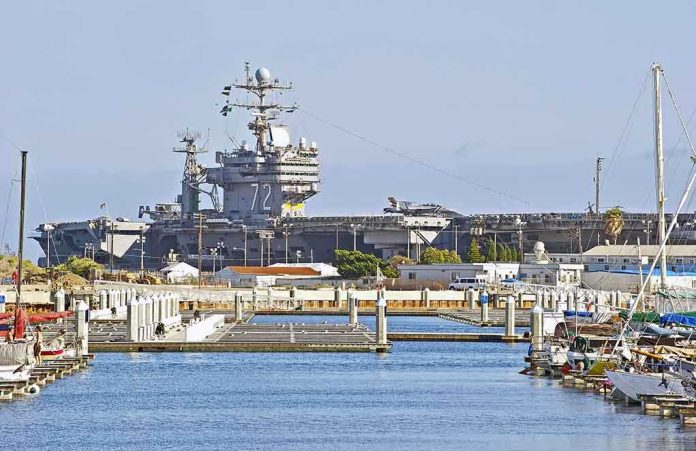
America’s largest aircraft carrier now shadows Venezuelan waters, but the real battle may be about far more than ships and missiles—it’s about the future balance of power in the Western Hemisphere.
Story Snapshot
- The USS Gerald R. Ford’s deployment marks the region’s biggest U.S. military buildup in decades.
- The official mission is counternarcotics, but analysts see clear signals of regime pressure.
- Venezuela’s government scrambles for support from Russia, China, and Iran, raising global stakes.
- The risk of military confrontation and regional destabilization now looms larger than at any time in recent memory.
U.S. Warships Arrive as Tensions with Venezuela Erupt
USS Gerald R. Ford, the world’s most advanced aircraft carrier, entered the Caribbean in late October 2025, accompanied by destroyers, submarines, and a full air wing. U.S. officials claim the operation aims to disrupt transnational criminal networks, but few regional observers accept this at face value. Venezuela’s President Nicolás Maduro, facing economic collapse and diplomatic isolation, has interpreted the buildup as a direct threat to his government. In the span of weeks, tense encounters have unfolded—fighter jets overflight, naval detentions, and U.S. bombers flying near Caracas—each ratcheting up anxiety that a single miscalculation could spark armed conflict.
Diplomatic protest notes have flown as thick as warplanes, but the military hardware speaks louder. The Ford’s presence, coupled with live-fire U.S. Marine drills and surveillance flights, signals Washington’s intent to remind both Maduro and his foreign backers—Russia, China, Iran—of its overwhelming regional might. The mood in Caracas is defiant, but behind closed doors, Maduro’s appeals for outside military assistance betray a recognition: Venezuela’s aging arsenal and battered economy offer little real deterrence against the world’s most formidable navy.
Why the Caribbean Matters: Power, Oil, and Precedent
The Caribbean’s strategic value is as old as the Monroe Doctrine: whoever controls these waters influences the entire hemisphere. For decades, U.S. naval operations here focused on drug interdiction and disaster response. The scale and sophistication of today’s deployment, however, recalls the Cold War era more than the “War on Drugs.” With bombers flying just miles from Venezuelan airspace and intelligence assets mapping every move on the ground, the message is unambiguous—Washington will not tolerate what it sees as a hostile regional foothold by rival powers.
Venezuela’s economic lifeblood—oil—moves through these contested waters. Any disruption could ripple across global energy markets, adding economic pressure to Maduro’s regime and hardship for ordinary Venezuelans. Previous U.S. interventions in Latin America have left scars and skepticism, but the involvement of Russia, China, and Iran this time introduces a new complexity. Their support for Maduro, ranging from intelligence sharing to possible arms deliveries, risks turning a regional standoff into a multi-sided confrontation, the kind that can upend alliances and redraw diplomatic maps.
Escalation, Uncertainty, and the Risks Ahead
Military buildups are rarely about what is said in press briefings. The Ford’s deployment is a coercive signal, not a prelude to open invasion—at least, that’s the prevailing view among most security experts. The danger lies in the fog of confrontation: with U.S. and Venezuelan jets flying close, warships shadowing each other, and political leaders trading threats, even a minor incident could spiral out of control.
For the region’s fragile economies, the stakes are immediate. Oil exports, maritime commerce, and even tourism could collapse if hostilities break out. Refugee flows from Venezuela’s battered population would increase, straining neighboring states already struggling with their own crises. American military personnel and their families, meanwhile, wait and watch, as the world wonders whether this is just the latest chapter in a century-old cycle of showdowns—or the start of something more profound.
Global Players Crowd the Stage: What Comes Next?
Moscow’s decision to land military aircraft in Venezuela and Beijing’s diplomatic overtures make clear this is more than a bilateral spat. The U.S. faces more than Maduro’s rhetoric; it must weigh the risks of a proxy conflict with other major powers. Each new move—military exercises, arms shipments, surveillance flights—raises the temperature, and the world’s media watches for the next flashpoint.
There is little sign of de-escalation. Both sides hold to maximalist positions: Washington demands a rollback of foreign influence and criminal activity, while Caracas clings to sovereignty and survival. The Organization of American States and regional governments issue calls for calm, but the machinery of confrontation grinds forward. For U.S. strategists, the challenge is to project strength without blundering into a wider war—no easy feat in a hemisphere where every move is now watched in Moscow, Beijing, and Tehran as closely as in Washington or Caracas.
Sources:
Wikipedia: 2025 United States naval deployment in the Caribbean










